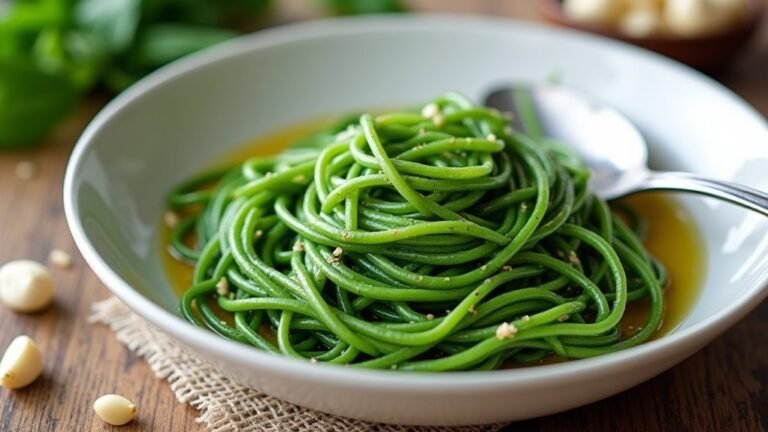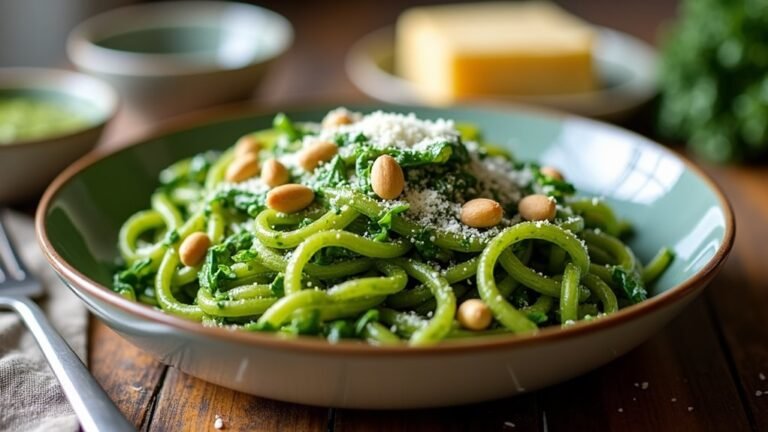Artichoke Pasta Recipe: Creamy and Savory
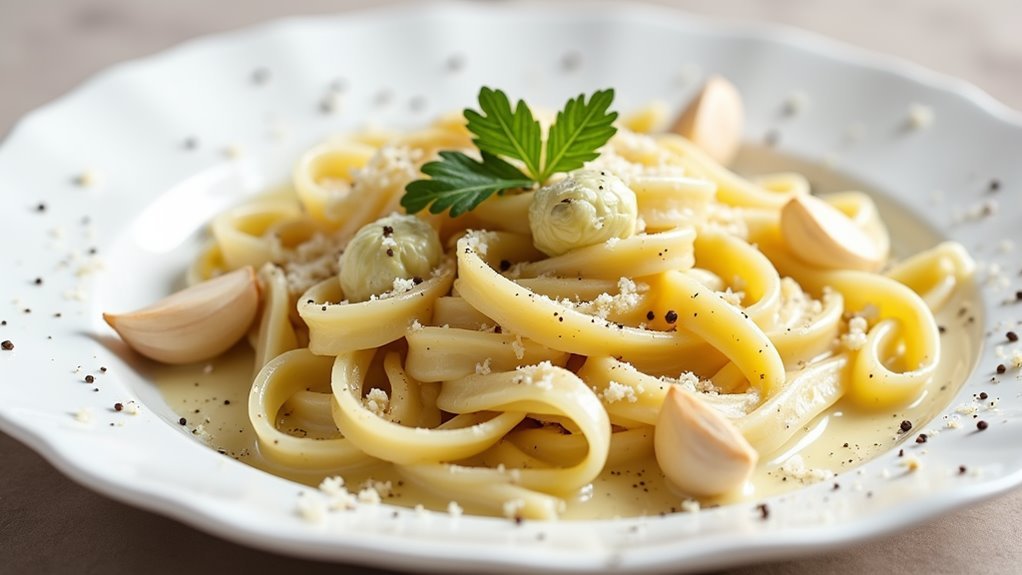
Artichoke pasta might seem complex, but it's surprisingly simple with just five core ingredients. Picture fettuccine intertwined with tender artichoke hearts, enveloped in a creamy sauce enhanced by Parmesan's sharpness and the warmth of sautéed garlic.
It's not just about following steps; mastering timing and texture can elevate this dish into something memorable. Could this become your go-to recipe for impressing guests or enjoying a cozy night in?
Key Takeaways
- Combine fettuccine with a creamy sauce using heavy cream and Parmesan cheese.
- Sauté garlic in olive oil to enhance the pasta's aromatic depth.
- Use canned artichoke hearts for texture and subtle tanginess in the dish.
- Reserve pasta water to adjust the sauce's consistency to your preference.
- Experiment with flavors by adding chili flakes or trying different cheeses.
Recipe
Artichoke pasta is a delightful dish that brings together the earthy flavors of artichoke hearts with the creamy texture of a rich sauce, all enveloped in perfectly cooked pasta. This dish is an excellent option for both quick weeknight meals and special occasions, thanks to its simplicity and elegance. With only five core ingredients, this recipe emphasizes the harmonious blend of flavors, ensuring a satisfying experience with every bite.
The artichoke hearts provide a subtle tanginess, while the heavy cream and Parmesan cheese create a luscious sauce that clings to each strand of pasta. The garlic enhances the overall flavor, adding a fragrant depth to the dish. Whether you're looking to impress guests or simply enjoy a comforting meal at home, this artichoke pasta is sure to become a favorite.
Ingredients:
- Fettuccine pasta (16 oz)
- Canned artichoke hearts (14 oz)
- Heavy cream (1 cup)
- Parmesan cheese (1/2 cup, grated)
- Garlic (4 cloves)
To prepare the artichoke pasta, start by cooking the fettuccine in salted boiling water according to the package instructions. While the pasta is cooking, mince the garlic and sauté it in a large pan over medium heat until fragrant.
Add the drained and chopped artichoke hearts to the pan and cook for about 2 minutes. Pour in the heavy cream and bring the mixture to a simmer, cooking until slightly thickened.
Once the pasta is done, drain it and add it to the pan with the sauce. Sprinkle the Parmesan cheese over the pasta and toss everything together until well coated. Season with salt and pepper to taste, and serve immediately.
For best results, remember to reserve 1/2 cup of pasta cooking water before draining. This starchy water can help adjust the consistency of the sauce if it becomes too thick.
It's important to thoroughly drain and pat dry the artichoke hearts to avoid a watery sauce. While fettuccine is recommended, feel free to use any long pasta like linguine or spaghetti if preferred. Enjoy this dish hot and creamy for the best flavor experience.
Cooking Steps
Get ready to create a culinary masterpiece by starting with boiling your fettuccine in salted water until perfectly al dente.
While your pasta cooks, you'll sauté minced garlic until it fills your kitchen with its rich aroma, then add artichokes for a quick two-minute cook.
As the cream simmers and thickens, toss it all together with the pasta, sprinkling in Parmesan until everything is coated in a luscious, creamy sauce that's simply irresistible.
Step 1. Boil Fettuccine in Salted Water
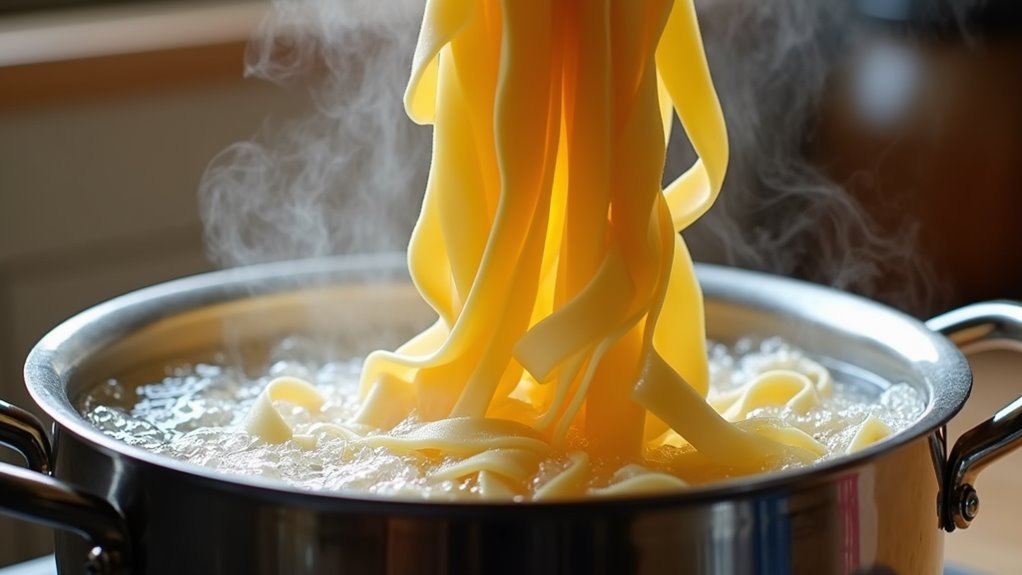
Start by bringing a large pot of salted water to a rolling boil to cook your fettuccine. The salt not only seasons the pasta but also enhances its texture, making it the perfect base for your creamy artichoke sauce.
Once the water is bubbling vigorously, add your fettuccine, stirring occasionally to prevent sticking. Use this time to gather your other ingredients, ensuring you're ready for the next steps.
Cooking pasta is an art, so taste a strand a minute or two before the package suggests—it should be al dente, tender yet firm to the bite.
Once the pasta reaches perfection, reserve half a cup of the starchy cooking water. Then, drain and set the fettuccine aside, ready to absorb all those delicious flavors.
Step 2. Sauté Minced Garlic Until Fragrant
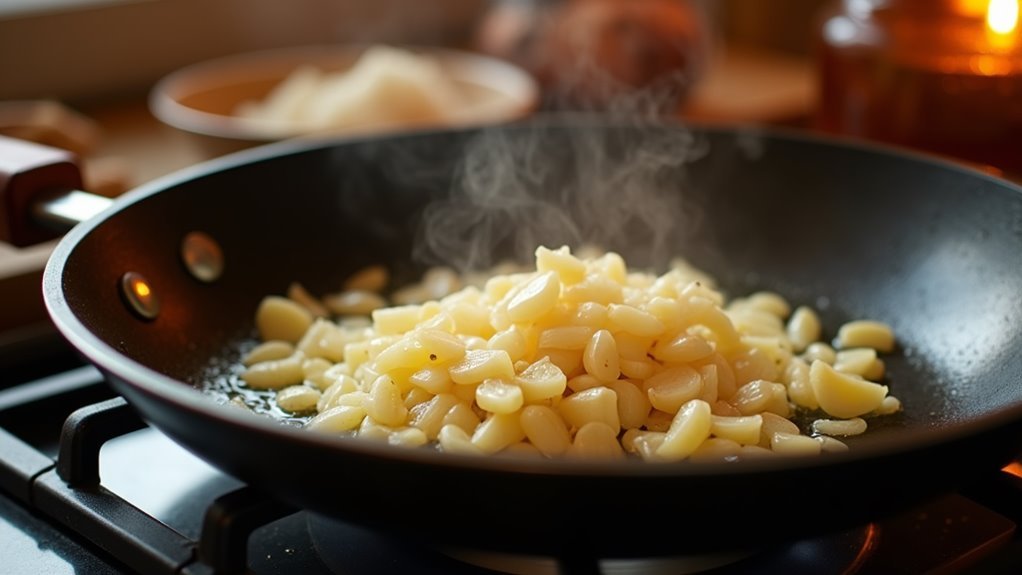
Aromas of garlic will soon fill your kitchen as you sauté the minced cloves until they're fragrant.
You'll want to heat a generous splash of olive oil in a large pan over medium heat before adding the garlic. Stir it gently, letting the golden hue develop without burning. The sizzling sound is your cue that flavor magic is happening, transforming your kitchen into a fragrant haven.
This step is essential because the garlic's rich aroma and subtle sweetness set the stage for the creamy artichoke pasta.
Sautéing garlic brings out its best qualities, providing a savory depth that elevates the entire dish. So embrace this aromatic moment, knowing you're laying the foundation for a truly delicious meal.
Step 3. Cook Artichokes for Two Minutes
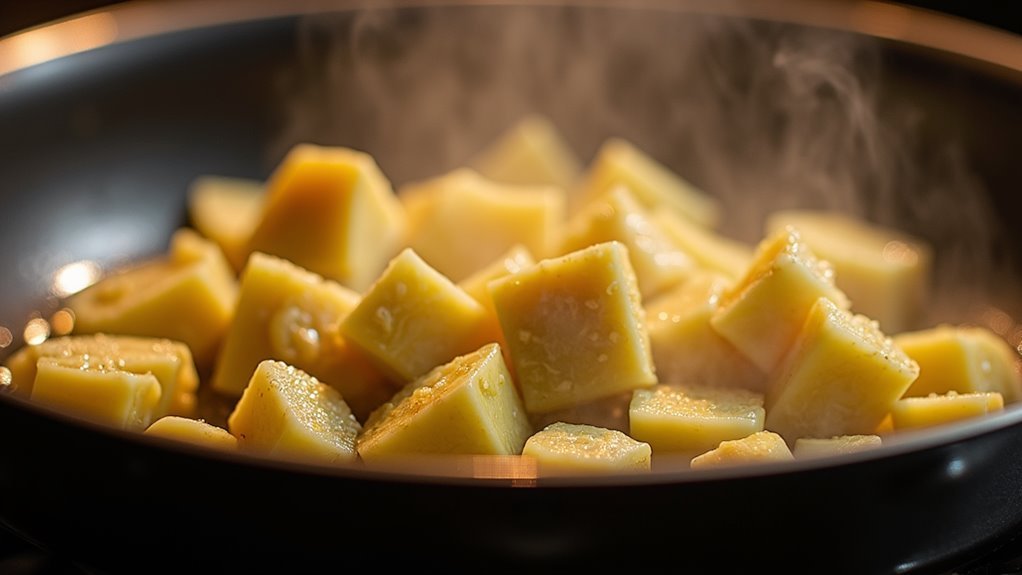
As the garlic's enticing aroma lingers, it's time to introduce the artichoke hearts into the mix.
Pour them into the pan, watching as they sizzle and soak up the fragrant garlic goodness. Make sure they're evenly distributed, ensuring each piece has its moment in the spotlight.
Stir them gently, letting them mingle and dance with the garlic for just two minutes. This brief cooking time is crucial, giving the artichokes a chance to warm through and absorb all those mouthwatering flavors without losing their delightful texture.
You'll notice the transformation—artichokes turning tender, slightly golden, and ready to add their subtle tang to your creamy pasta dish.
It's a quick step that sets the stage for an unforgettable meal.
Step 4. Simmer Cream Until Thickened
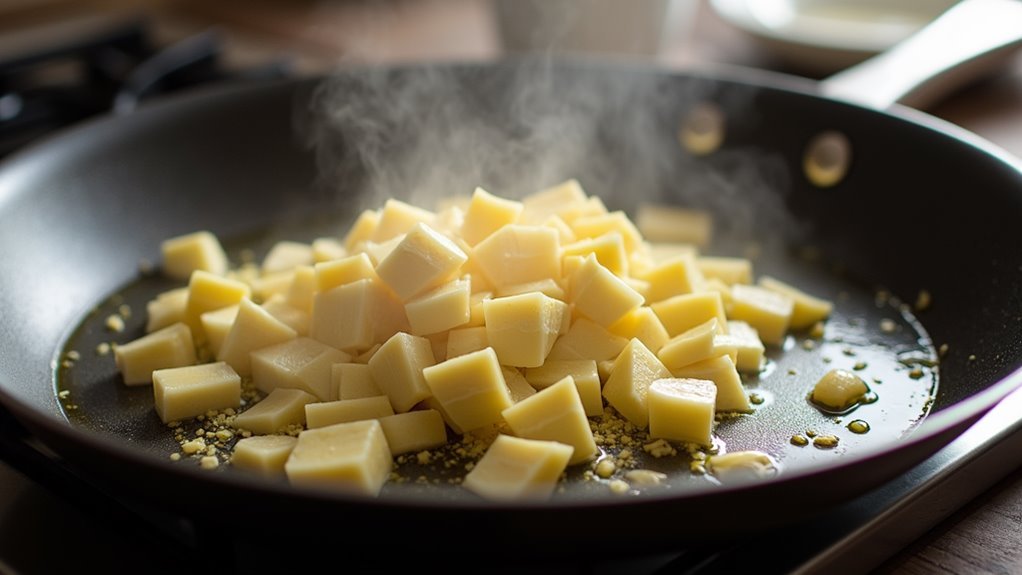
With the artichokes perfectly warmed and infused with garlic, it's time to pour in the heavy cream.
Feel the excitement as you watch the cream swirl and blend with the artichokes and garlic, creating a rich, fragrant base.
Bring the mixture to a gentle simmer, letting the cream bubble softly. This process allows it to thicken slightly, transforming into a luscious sauce that clings beautifully to the pasta.
Keep an eye on it, stirring occasionally, so it doesn't stick to the pan. The key is patience—let the cream reduce until it coats the back of a spoon.
This step is crucial for achieving that velvety texture. Embrace the aromas filling your kitchen, as you prepare this delightful dish!
Step 5. Toss Pasta With Sauce
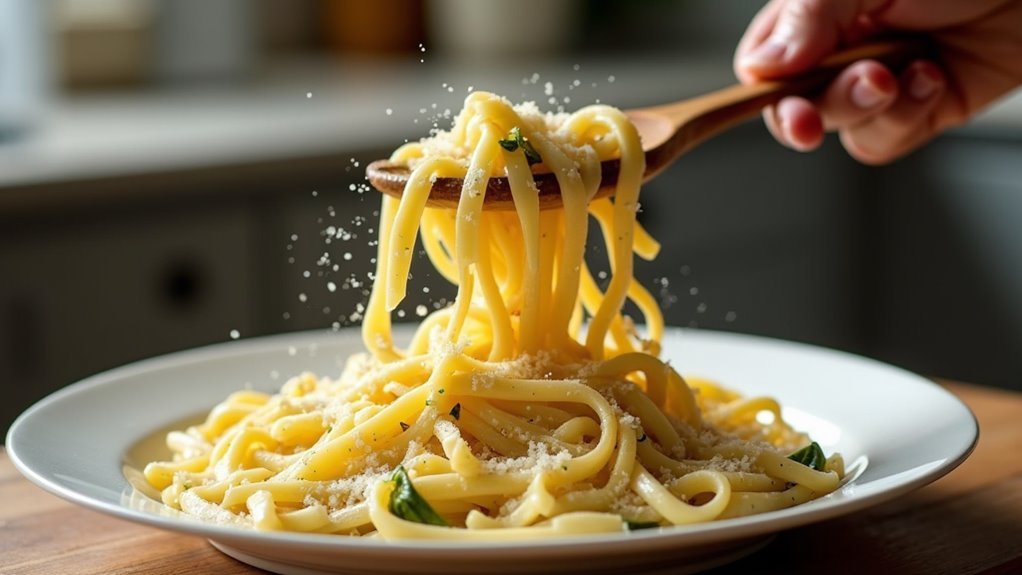
Now that your sauce is perfectly thickened, it's time to combine it with the pasta.
Drain the fettuccine, but don't forget to reserve about 1/2 cup of the cooking water. This starchy water is your secret weapon to ensure the sauce is just the right consistency.
Toss the hot pasta into the pan with your creamy artichoke sauce. Stir gently, letting the sauce cling to each strand, while the Parmesan melts into a rich, savory coating.
If the sauce feels too thick, add a splash of the reserved pasta water until it's silky smooth. Season with salt and pepper to taste.
As you mix, feel the excitement of creating a restaurant-quality dish right in your kitchen! Enjoy each delicious bite.
Final Thoughts
The artichoke pasta dish you've just created is a delightful testament to the power of simplicity in cooking. With just five ingredients, it transforms into a creamy, savory masterpiece that's perfect for any occasion.
You've experienced how the earthy artichokes blend seamlessly with the rich sauce and tender pasta, creating harmony on your plate. This recipe isn't just about feeding your body; it's about feeding your soul with comfort and satisfaction.
Don't hesitate to experiment with this dish. Try adding a sprinkle of chili flakes for heat, or swap Parmesan for Pecorino to change up the flavor.
Whether you're a seasoned cook or a kitchen novice, this recipe invites you to enjoy the art of cooking and share it with those you love.
Frequently Asked Questions
Can I Use Fresh Artichokes Instead of Canned?
Absolutely, you can use fresh artichokes! First, trim and cook them until tender, then remove the hearts.
Fresh artichokes add a delightful, vibrant flavor that's hard to beat. Although it takes a bit more time than using canned, the result is worth it.
Just make sure to remove the choke and any tough outer leaves. Your pasta will taste fresher and more homemade, giving you a truly special dish to enjoy!
What Wine Pairs Well With Artichoke Pasta?
You're in for a treat! Pairing wine with artichoke pasta can be a delightful experience.
Go for a crisp, aromatic white wine like Sauvignon Blanc or Pinot Grigio.
These wines have a zesty acidity that complements the creamy sauce and tangy artichokes beautifully. Their refreshing notes balance the richness of the dish, enhancing each bite.
Pour yourself a glass, savor the flavors, and enjoy your culinary adventure!
Is There a Dairy-Free Alternative for Heavy Cream?
You're in luck! Finding a dairy-free alternative to heavy cream isn't hard.
Imagine the velvety goodness of coconut cream, swirling into your dish with its rich texture and subtle sweetness. It's a versatile substitute, perfect for keeping that creamy consistency without dairy.
You can also blend soaked cashews with water for a smooth, nutty cream. Both options maintain the dish's luxurious feel while catering to your dairy-free needs.
Enjoy experimenting!
How Can I Add Protein to This Dish?
To boost protein in this dish, add grilled chicken or sautéed shrimp, which pair beautifully with the flavors.
Simply cook your protein choice separately, then toss it into the pasta just before serving.
You could also mix in white beans or chickpeas for a vegetarian option that provides a protein punch.
These additions not only enhance the dish's nutritional value but also add delicious texture and heartiness.
Enjoy your protein-packed meal!
Can I Prepare the Sauce in Advance?
You can absolutely prepare the sauce in advance!
It's a coincidence that this sauce happens to get even better as the flavors meld together. Just make sure to cool it completely, then store it in an airtight container in the fridge.
When you're ready to use it, gently reheat the sauce over low heat, stirring occasionally. If it thickens too much, just add a splash of milk or cream to bring it back to life.


